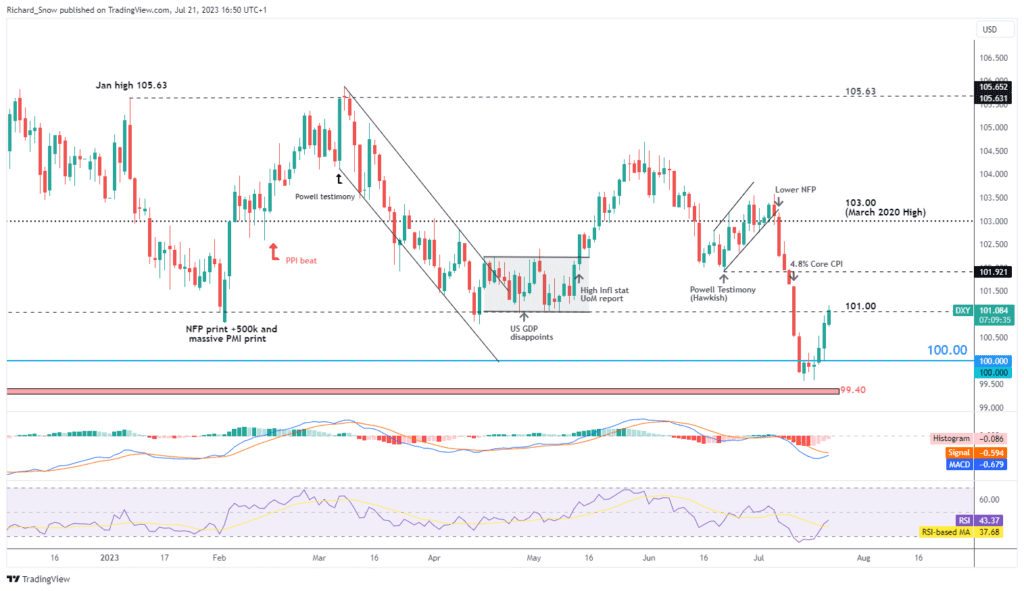In the context of the US Dollar forecast, there has been a notable resurgence of the US Dollar (USD), displaying strength against weaker G7 currencies. The Dollar Index (DXY) witnessed a lift as major counterparts, such as the euro, pound sterling, and Japanese yen, relinquished some of their recent gains. With market participants eagerly anticipating the Federal Reserve’s Federal Open Market Committee (FOMC) meeting and critical economic data, the trajectory of the dollar remains uncertain. In this article, we will delve into the factors contributing to the recent USD resurgence, analyze the potential impact of the upcoming FOMC meeting, and assess key economic data that could influence the dollar’s short and long-term direction.
US Dollar Forecast: USD Gains Momentum Amidst Weaker G7 Currencies – FOMC Meeting and Economic Data Awaited for Direction
The DXY, a widely recognized benchmark for the USD’s performance, has witnessed a recent uptick primarily driven by the weakening of major G7 currencies. Among these, the euro faced headwinds as the European Central Bank’s (ECB) hawk, Klaas Knot, admitted an uncertain outlook on future rate hikes. The eurozone’s economic recovery and the path of monetary policy have been closely monitored by market participants, and Knot’s comments added to the prevailing uncertainty.

Source: dailyFX
In the United Kingdom, the pound sterling faced pressure due to better-than-expected inflation figures, which lessened the need for aggressive rate hikes by the Bank of England. Investors have been closely observing inflation dynamics, as central banks’ responses to rising inflation can significantly impact currency values.
In Japan, officials continued to voice their support for the existing ultra-low monetary policy. This stance put downward pressure on the Japanese yen, contributing to the USD’s strength against the yen.
FOMC Meeting and USD Outlook
The forthcoming FOMC meeting is crucial for shaping the USD’s outlook. As inflation shows steady progress, the dollar’s bullish drivers are becoming scarcer. Federal Reserve Chairman Jerome Powell’s communication during the meeting will be closely scrutinized by market participants, as it can provide critical insights into the central bank’s policy stance and future rate hike expectations.

Source: dailyFX
One of the key concerns that Powell may address is global food price uncertainty arising from Vladimir Putin’s withdrawal from the Black Sea Grain Deal. Food prices and commodities play a significant role in global inflation dynamics, and any mention of this issue by Powell could influence market sentiment regarding inflation expectations.
Moreover, the FOMC meeting is likely to touch upon the committee’s favored inflation measure, core Personal Consumption Expenditures (PCE). Any indication of concerns over inflation or possible measures to address rising prices could have a substantial impact on the USD’s direction.
The current weekly chart suggests a bearish outlook for the USD in the longer term. However, in the short term, there is still potential for further upside. A close above 101.00 in the DXY could pave the way for a possible return to the June low of 101.92, with the 103 level becoming relevant once again. The technical indicators, such as the Moving Average Convergence Divergence (MACD) and the Relative Strength Index (RSI), also provide some support for further USD strength.
Market Expectations and Economic Data
Market participants have already priced in a 96% chance of a 25-basis point rate hike during the FOMC meeting. The possibility of another 25 basis point hike into the year-end appears unlikely at this stage, but it remains subject to change based on incoming data, such as Friday’s PCE print. The high consensus for the rate hike might lead to some easing off of the dollar’s strength after the rate decision.

Source: dailyFX
Looking ahead, economic data releases will play a crucial role in shaping market sentiment and the USD’s performance. The second revision of Q2 GDP data is highly anticipated, and any notable decline from the initial estimate of 2% to around 1.6% could result in some weakness for the dollar. However, it is important to note that despite potential revisions, the US economy continues to operate relatively well compared to its peers.
Additionally, on Friday, the release of core PCE data holds the potential to influence the current disinflationary narrative that has been taking hold since the core Consumer Price Index (CPI) print on July 12th. Should core PCE move lower, it may once again put the dollar in the firing line. The Fed’s tone and commentary during the FOMC meeting will be crucial in shaping market expectations regarding inflation and its potential impact on future monetary policy decisions.

Conclusion
The recent resurgence of the US Dollar has been driven by weakness in G7 currencies, positioning the DXY for potential bullish continuation. However, uncertainties persist, and the dollar’s future trajectory remains uncertain as market participants await the outcome of the FOMC meeting and key economic data releases. Powell’s communication during the meeting will play a crucial role in shaping market expectations and influencing the USD’s outlook in the short term. With several risk events in the week ahead, including economic data releases, traders should remain vigilant to navigate potential market fluctuations and seize opportunities in the dynamic foreign exchange landscape.
Click here to read our latest article on Dreadful German PMI Sends EUR/USD Below 1.11

